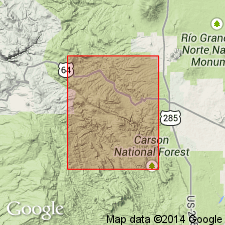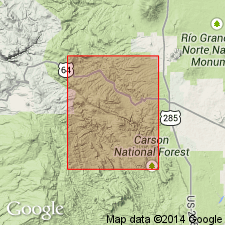
- Usage in publication:
-
- Kiawa Mountain formation
- Modifications:
-
- Original reference
- Dominant lithology:
-
- Conglomerate
- Quartzite
- Amphibolite
- AAPG geologic province:
-
- Southern Rocky Mountain region
Summary:
Pg. 1, 10, 24, pl. 1. Kiawa Mountain formation. Defined as the quartzite including and overlying the Big Rock conglomerate and overlying the Moppin metavolcanic series from Cleveland Gulch to Jawbone Mountain. Consists of (ascending) Big Rock
(new) conglomerate member, lower quartzite member, amphibolite member, Jawbone (new) conglomerate member, and upper quartzite member. Several thousand feet thick. Age is Precambrian.
Exposed on Kiawa Mountain and in other areas of Las Tablas quadrangle, [Rio Arriba Co., Carson National Forest area], central northern NM.
Source: US geologic names lexicon (USGS Bull. 1200, p. 2004-2005).

- Usage in publication:
-
- Kiawa Mountain Formation*
- Modifications:
-
- Principal reference
- Adopted
- AAPG geologic province:
-
- Southern Rocky Mountain region
Summary:
Pg. A10, A21, A22. Kiawa Mountain Formation of Barker (1958). Rocks previously included in Just's (1937) Ortega Quartzite. Consists principally of light blue to gray, vitreous, very fine-grained to medium-grained quartzite and some conglomerate and amphibolite. Thickness estimated to be 5,000 to 10,000 feet; top not preserved and intensively folded so thickness cannot be measured accurately. Includes Big Rock Conglomerate Member (Las Tablas quadrangle) and Jawbone Conglomerate Member (Burned Mountain quadrangle); stratigraphic relations of these members are unknown. Overlies Ortega Quartzite (restricted). To south, on [Mesa de la Jarita], grades into Petaca Schist. Age is Precambrian.
Type locality: Kiawa [Kiowa] Mountain, in secs. 3 to 5, 8 to 10, T. 27 N., R. [8] E., Las Tablas 7.5-min quadrangle, Rio Arriba Co., [Carson National Forest area], central northern NM.
Source: Publication.

- Usage in publication:
-
- Kiawa Mountain Formation*
- Modifications:
-
- Age modified
- AAPG geologic province:
-
- Southern Rocky Mountain region
Summary:
Age changed from Precambrian to Proterozoic X. Is younger than Burned Mountain Rhyolite of 1,750 to 1,800 m.y. and older than Maquinita Granite of 1,700 and 1,750 m.y. Mapped with an unnamed quartzite unit that includes Jawbone Conglomerate Member of Kiawa Mountain Formation and an upper quartzite member in report area, Southern Rocky Mountain region.
Source: GNU records (USGS DDS-6; Denver GNULEX).

- Usage in publication:
-
- Kiawa Mountain Formation*†
- Modifications:
-
- Abandoned
Summary:
Kiawa Mountain Formation and its Jawbone Conglomerate Member are abandoned. The vitreous quartzite at Kiawa Mountain is the Ortega Quartzite and the name Ortega has precedence as having been defined (1937) before the Kiawa Mountain (1958). The quartz-pebble conglomerate at Jawbone Mountain is part of the Ortega. The Big Rock Conglomerate Member is reassigned to the Burned Mountain Metarhyolite. The Proterozoic Kiawa Mountain and the Jawbone were known in Rio Arriba Co, NM in the Southern Rocky Mountain region.
Source: GNU records (USGS DDS-6; Denver GNULEX).
For more information, please contact Nancy Stamm, Geologic Names Committee Secretary.
Asterisk (*) indicates published by U.S. Geological Survey authors.
"No current usage" (†) implies that a name has been abandoned or has fallen into disuse. Former usage and, if known, replacement name given in parentheses ( ).
Slash (/) indicates name conflicts with nomenclatural guidelines (CSN, 1933; ACSN, 1961, 1970; NACSN, 1983, 2005, 2021). May be explained within brackets ([ ]).

